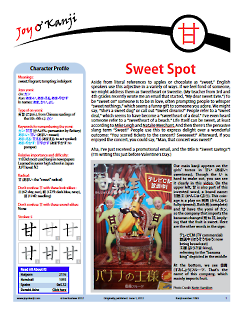甘
sweet; fragrant; tempting; indulgent; "sweet" radical
Kanji 1093
Thank you for visiting this Character Home Page. Below you'll find a synopsis of the essay. If you wish to read the full text, the PDF of the essay is available for purchase to the right.
Even though 甘い (あまい) seems ultra-simple, it has six definitions! Some are straightforward (e.g., sweet tastes and smells). Others are unexpected, as when "sweet" words deceive or spoil others. You'll learn the term for "sweet tooth" and for its opposite, a word that has nothing to do with food! You'll also find out about 甘 as a radical in eight Joyo kanji.
Revision history:
Feb. 21, 2025:
- p. 9: Reformatted and rewrote the photo caption, also fixing a yomi error and a punctuation problem.
- p. 10: Reformatted and rewrote the photo caption, also improving some definitions.
Dec. 20, 2024: p. 2: Changed "sticky-sweet" to "sickly sweet." I believe that's the word I meant to use way back when.
June 25, 2021: p. 17: Changed the definitions of 勘 (1100) and slightly updated Henshall’s etymology of 其.
Jan. 2–4, 2020:
- p. 2: Etymology Box: Replaced the old Henshall etymology with the new one.
- p. 6: Slightly changed the last sample sentence and its translation, as well as the subsequent explanation.
- p. 10, photo caption: Improved the translation of the sign and deleted the last paragraph in the caption.
- p. 11: Slightly changed the definition of 頂く.
- p. 16: Slightly changed the definition of 取って代わる.
Mar. 31, 2018:
- p. 6: Removed a broken link.
- p. 10: In the photo caption I have now defined 木 as "wood" (not tree) and 成熟 as a noun (not a verb). I also explained some of the syntax in the sign.
June 1, 2012: Originally published.



Comments